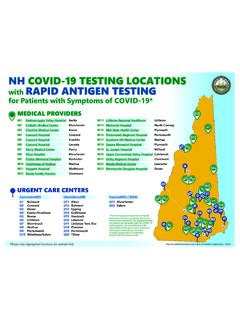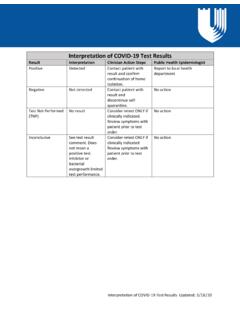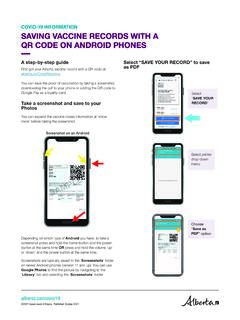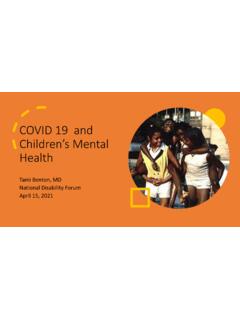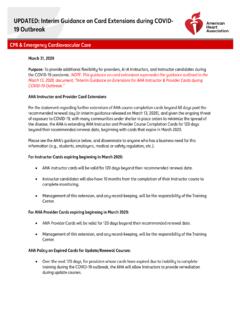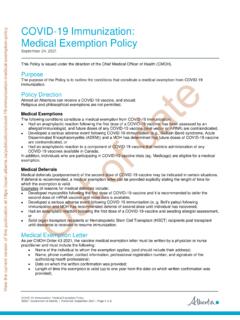Transcription of Bureau of Infectious Disease Control ... - covid19.nh.gov
1 NH Department of Health and Human Services Division of Public Health Services Bureau of Infectious Disease Control Bureau of Infectious Disease Control January 7, 2022 Isolation & Quarantine Recommendations for the General Public The tables below summarize CDC s updated isolation and quarantine guidance for the general public, which has been adapted by New Hampshire. CDC also explains the reasoning behind their updated guidance with answers to frequently asked questions (see Quarantine & Isolation Background). This guidance applies to the general public, including workplaces, K-12 schools and post-secondary institutions. This guidance does NOT apply to healthcare settings, correctional institutions, or homeless shelters. Healthcare organizations should refer to CDC s separate Interim Guidance for Managing Healthcare Personnel with SAR S-CoV-2 Infection or Exposure, and their Strategies to Mitigate Healthcare Personnel Staffing Shortages.
2 Persons who should isolate Recommended Action Any person who tests positive for COVID-19 or who has symptoms of COVID-19 while awaiting testing regardless of vaccination status, previous infection, or lack of symptoms. (Note: CDC recommends longer periods of isolation for people who are severely ill with COVID-19 and require hospitalization or intensive care unit support, or for people with severely compromised immune systems.) Stay home and away from others (including people in your household)for at least 5 days. Isolation can end after day 5 if you are fever-free (off fever-reducingmedications) for at least 24 hours and other symptoms are improving. If fever has been present in the prior 24 hours, or if other symptomsare not improving, then you should continue to isolate until fever freeand symptoms are improving for at least 24 hours, or until after 10days of isolation. For 10 days:oWear a well-fitting face mask when around other people who are immunocompromised or at high-risk forsevere travel, if : per CDC guidance, you can take an antigen test on day 5 before ending isolation and, if positive, you should continue to isolate for a total of 10 days.
3 Individuals and businesses/organizations can consider but do not have to adopt this testing strategy. Persons who should quarantine after being exposed to someone with COVID-19 Recommended Action Household contacts who are either: Unvaccinated; OR Not up to date on receiving allrecommended COVID-19 vaccine doses Stay home and away from others for 5 days after the last exposure. Watch for symptoms for COVID-19 for 10 days after the last exposure,and get tested if symptoms develop. Get tested at least 5 days after the exposure, even if no symptomsdevelop. If positive, move to isolation. For 10 days:oWear a well-fitting face mask when around other people who are immunocompromised or at high-risk forsevere travel, if Department of Health and Human Services Division of Public Health Services Bureau of Infectious Disease Control Bureau of Infectious Disease Control January 7, 2022 Persons who do NOT need to quarantine after being exposed to someone with COVID-19 Recommended Action Lower risk exposures in the community setting ( , non-household contacts) Household contacts who are up to date on receiving all recommended COVID-19 vaccine doses Unvaccinated household contacts who are within 90 days of testing positive for COVID-19 by antigen or PCR-based testing Wear a well-fitting face mask around other people for 10 days, especially in indoor settings.
4 If symptoms develop, stay home and get tested for COVID-19. Get tested for COVID-19 on day 5, even if you don t have symptoms. If testing is positive, follow isolation recommendations above. Definitions: Isolation: For people who are sick or who have tested positive for the COVID-19 virus. Quarantine: For people who have been exposed to the COVID-19 virus and are at risk for developing infection. Household contact: Any person who lives or sleeps in the same indoor shared space as another person diagnosed with COVID-19 (either a temporary or permanent living arrangement) leading to exposure to the person with COVID-19. Up to date on COVID-19 vaccination: A person is up to date on COVID-19 vaccination when they have completed a primary COVID-19 vaccine series (the single-dose J&J Janssen vaccine, or a 2-dose series of the Pfizer-BioNTech or Moderna vaccine) AND any booster shots which they are eligible for and recommended to receive. CDC has information about staying up to date on COVID-19 vaccination and who should get a booster shot.
5 Unvaccinated: Any person who has NOT completed a primary COVID-19 vaccine series.







